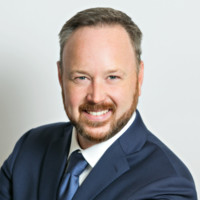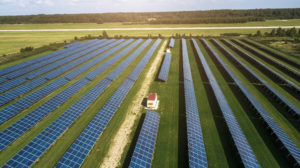Hurricanes in the East. Wildfires in the West. Those are the big disasters that grab the headlines and are driving property insurance costs and cancellations, to a large degree, right?
Yes, but insurers also are seeing a huge increase in unnamed convective storms, including tornadoes, derechos, other straight-line winds, hail and even lightning, especially in the Midwest and parts of the South, a trend that is having a growing impact on the cost of building projects.
And it’s all made more expensive by population and property growth in areas that were once considered relatively safe from major catastrophes.
That’s the view from Blake Berscheid, vice president of energy and complex property for Florida-headquartered Brown & Brown Insurance, one of the country’s largest insurance brokerages.

“Things are going through the roof, almost exponentially,” Berscheid said in an interview this week with Insurance Journal. “The number of billion-dollar events and the total costs over the last three years, in particular.”
A report from the National Oceanic and Atmospheric Administration in September examined the growing costs from all types of weather disasters, including fires and hurricanes. Berscheid looked at NOAA data for smaller but still-costly storms. He found that from 1980 to 2005, the US saw just 2 to 4 severe convective storms – not hurricanes or tropical storms – per year that produced losses of $1 billion or more.
But in the last six years, the number has jumped to 18 such events annually, on average.
And for the last four decades, the average annual loss was about $9 billion. For the last three years, the annual loss has soared to $27 billion. This year alone, through August, the economic losses have reached $44 billion from severe convective storms.
The most affected areas include Texas, Oklahoma, Kansas and Nebraska – the historic stretch known as tornado alley, Berscheid noted. But more convective storms also are pounding Midwestern areas outside the alley, including Iowa, and appear to be increasing in Dixie Alley – Alabama and Mississippi – the part of the South that has historically seen its share of tornadoes through the years. One 2018 study backs up that data and suggests that the pattern of tornadoes is shifting to the east.
A 2023 study by Swiss Re Management and Swiss Re Institute, part of the global reinsurance firm, argues that the mounting property losses are not necessarily from climate change. While convective storms have increased, the higher loss amounts are due in part to inflation and to the fact that many more structures and people are now in harm’s way.
“Rather than the physical destructive force of natural catastrophes themselves, the main driver of resulting high losses are economic growth, accumulation of asset values in exposed areas, urbanization and rising populations, often in regions susceptible to natural perils,” the Swiss Re Sigma report noted.
Solar and wind farms also are spreading rapidly in some of the areas now considered hotspots for convective storms, said Berscheid, whose Brown & Brown clients include a number of solar installations.
“Solar, particularly, is susceptible to hail damage. Glass and big ice balls don’t mix well together,” he noted. “That’s become a big factor in the renewable energy space.”
The number of solar farms has exploded across much of the country, often on ranch or farm lands that previously had little need for property insurance coverage. California leads the way with far more generating capacity than any other state, followed by Texas, Florida, Arizona and North Carolina, the U.S. Energy Information Administration reported in August. Some of the world’s largest solar arrays are now in Indiana and other parts of the Midwest.

While most solar panels are glazed with tempered glass, larger chunks of hail can still cause significant damage. A report in Renewable Energy World showed a Nebraska sun farm that had been smashed extensively by a hail event in June. In Texas, summer hail in 2022 caused more than $300 million in damage to solar farms, Solar Power World wrote in May.
Some insurance carriers and brokers are adjusting to the convective invective and the population boom, Berscheid said. FM Approvals, associated with FM Global, the commercial property insurer, continues to produce updated lists of recommended building materials, including a hail rating for roof assemblies. Other insurers are making greater use of computer modeling and maps to rate risks on properties that until recently had little risk data available.
The key is to communicate with clients early on about the growing risks from non-named storm events, so that they will know that premiums and deductibles will likely be higher than they expected while policy limits may be lower, Berscheid said.
“With that discussion, insureds are able to go into a project with both eyes open and understanding what the risks are and how they may be impacted,” he said. “We’re even seeing some where they may have to look at buying excess insurance for severe convective storms – hail in particular. Or, they may see incremental premiums or may need to go with a deductible buy-down policy to get their deductible in line with their risk appetite.”
Deductible buy-down policies typically cover the cost of the deductible on a primary policy, with a much lower deductible of their own. Typical all-perils policies will cover severe convective storm damage, but at lower limits than what many clients need, Berscheid explained. Adding extra convective coverage can cost 15% to 30% of an all-risk policy, or more, depending on locale.
“So, adding additional limits in an excess severe convective storm policy can be very spendy,” he noted.
Newer building codes and material choices are helping. Some areas now require more robust building materials and techniques, or insureds may elect to harden their properties or go with a metal roof or heavier-gauge shingles to protect against hail and wind damage.
“My advice is to get with clients, the earlier the better, especially on new projects,” Berscheid said. “Look at the modeling; understand the risks and communicate the risks to clients to make sure they understand as they acquire new locations or build in new places.”
Brokers may need to add additional risks or higher expected costs that insurers did not consider in years past.
“Surprises are never good, especially for insurance costs,” Berscheid said.
Top photo: Hail damage in Michigan in July. (Ryan Garza/Detroit Free Press via AP)
Was this article valuable?
Here are more articles you may enjoy.


 Hermès Heir Sues Arnault and LVMH in $16 Billion Suit Over Lost Shares
Hermès Heir Sues Arnault and LVMH in $16 Billion Suit Over Lost Shares  How Three New CMS Policies Impact Workers’ Comp Claims
How Three New CMS Policies Impact Workers’ Comp Claims  ‘Super Roofs’ Are Rewarding Insurers, Cat Bond Investors and Homeowners
‘Super Roofs’ Are Rewarding Insurers, Cat Bond Investors and Homeowners  Losses Top $20 Billion in Asia Floods as Climate Risks Grow
Losses Top $20 Billion in Asia Floods as Climate Risks Grow 